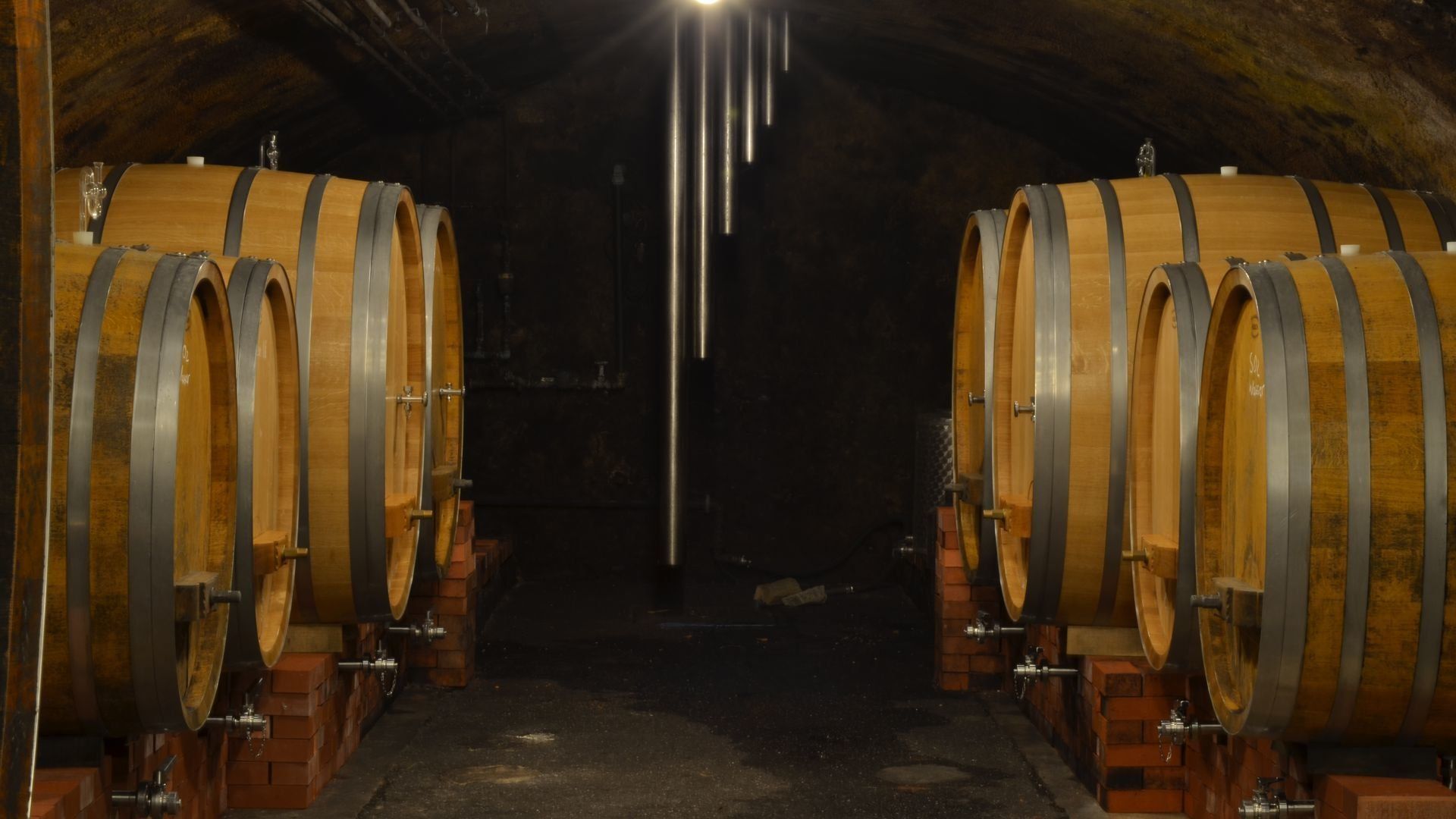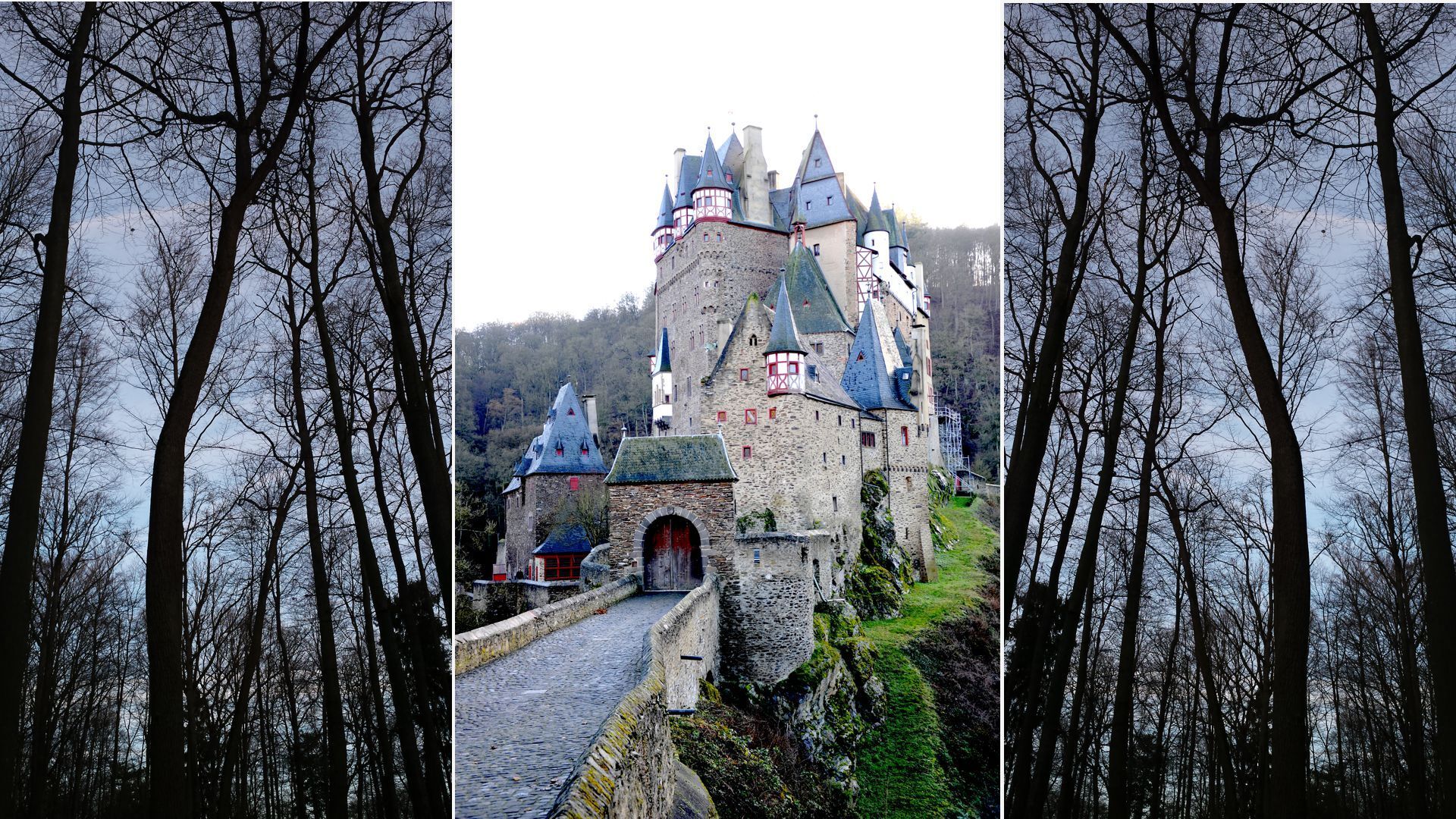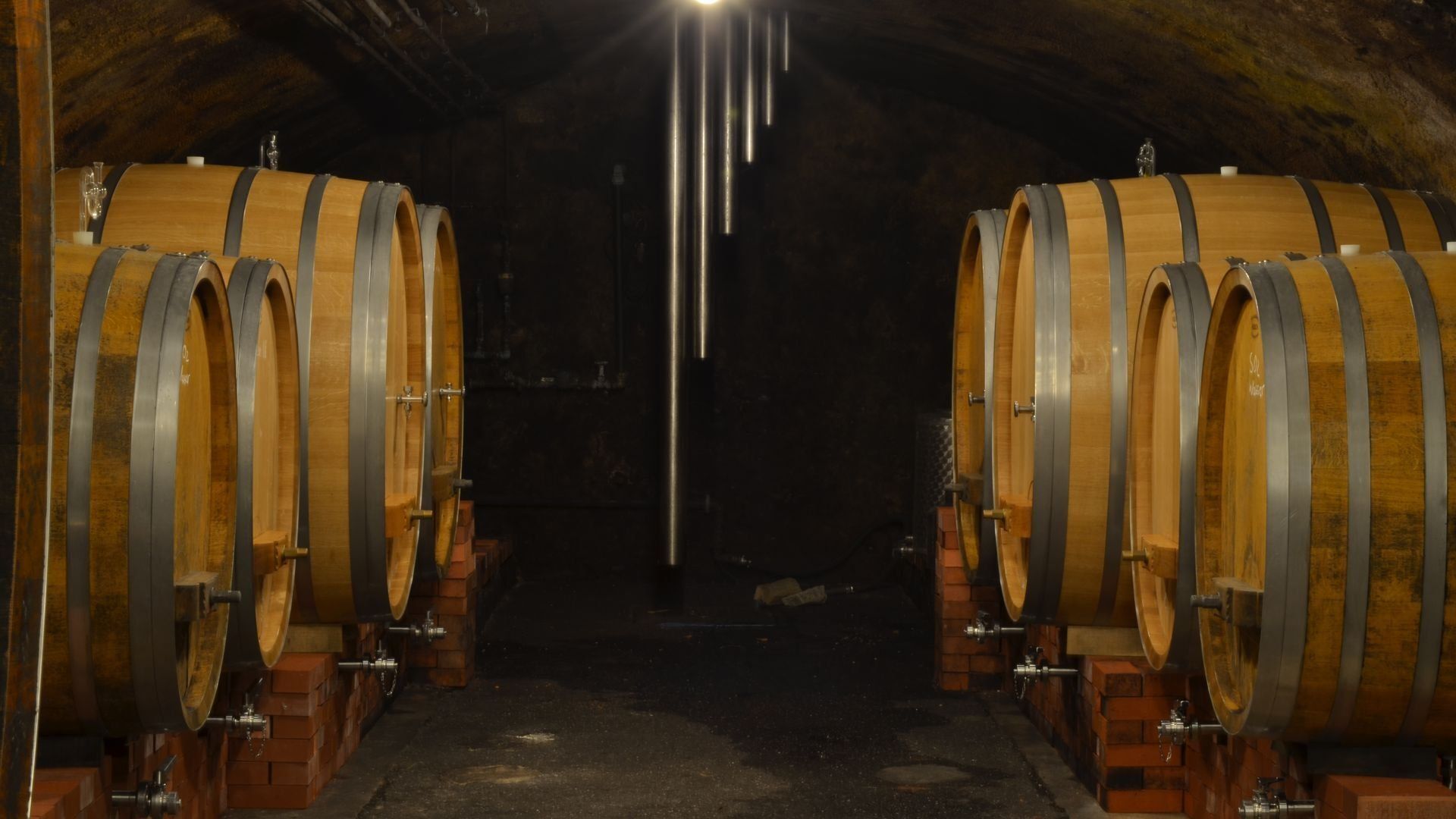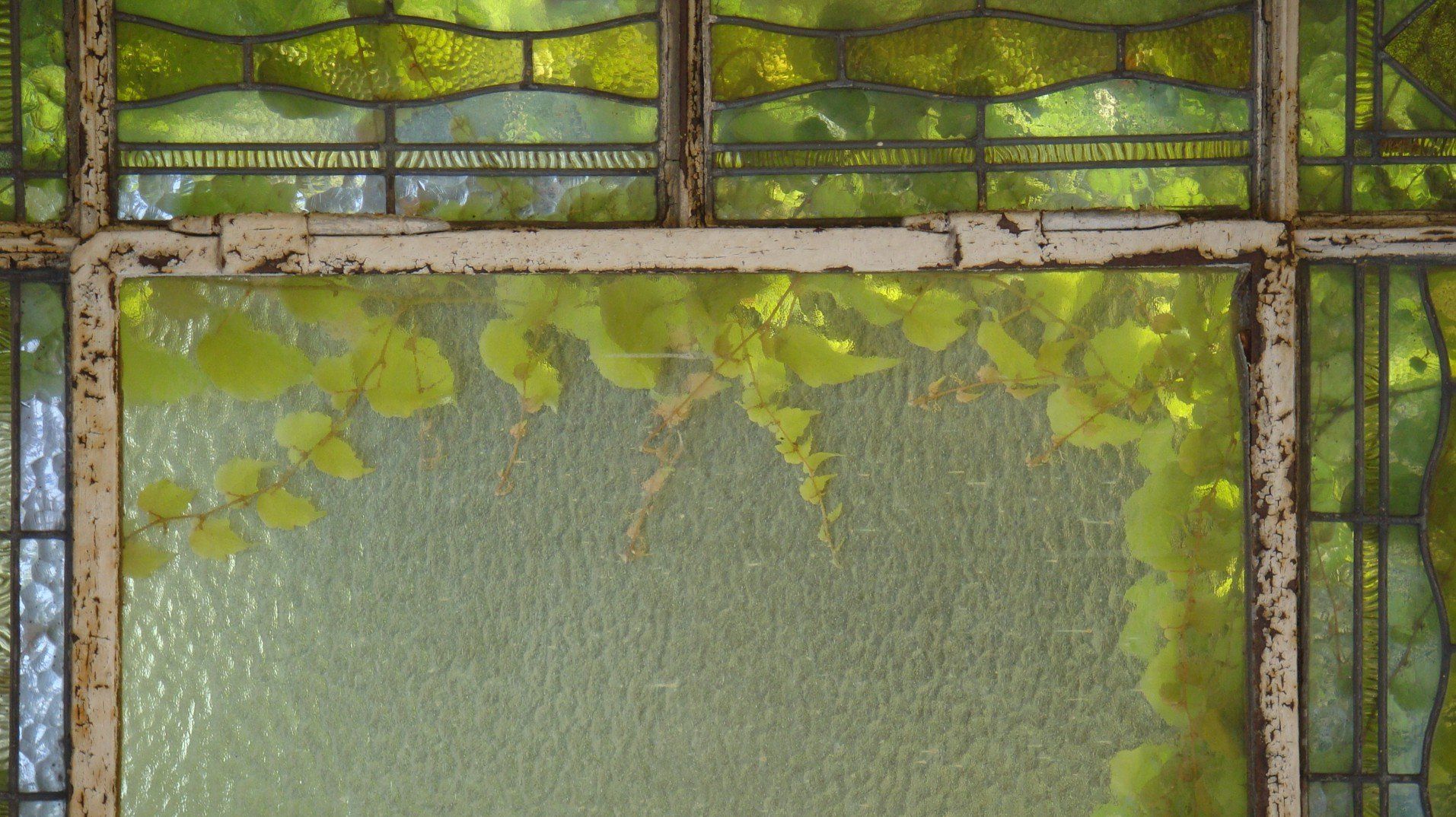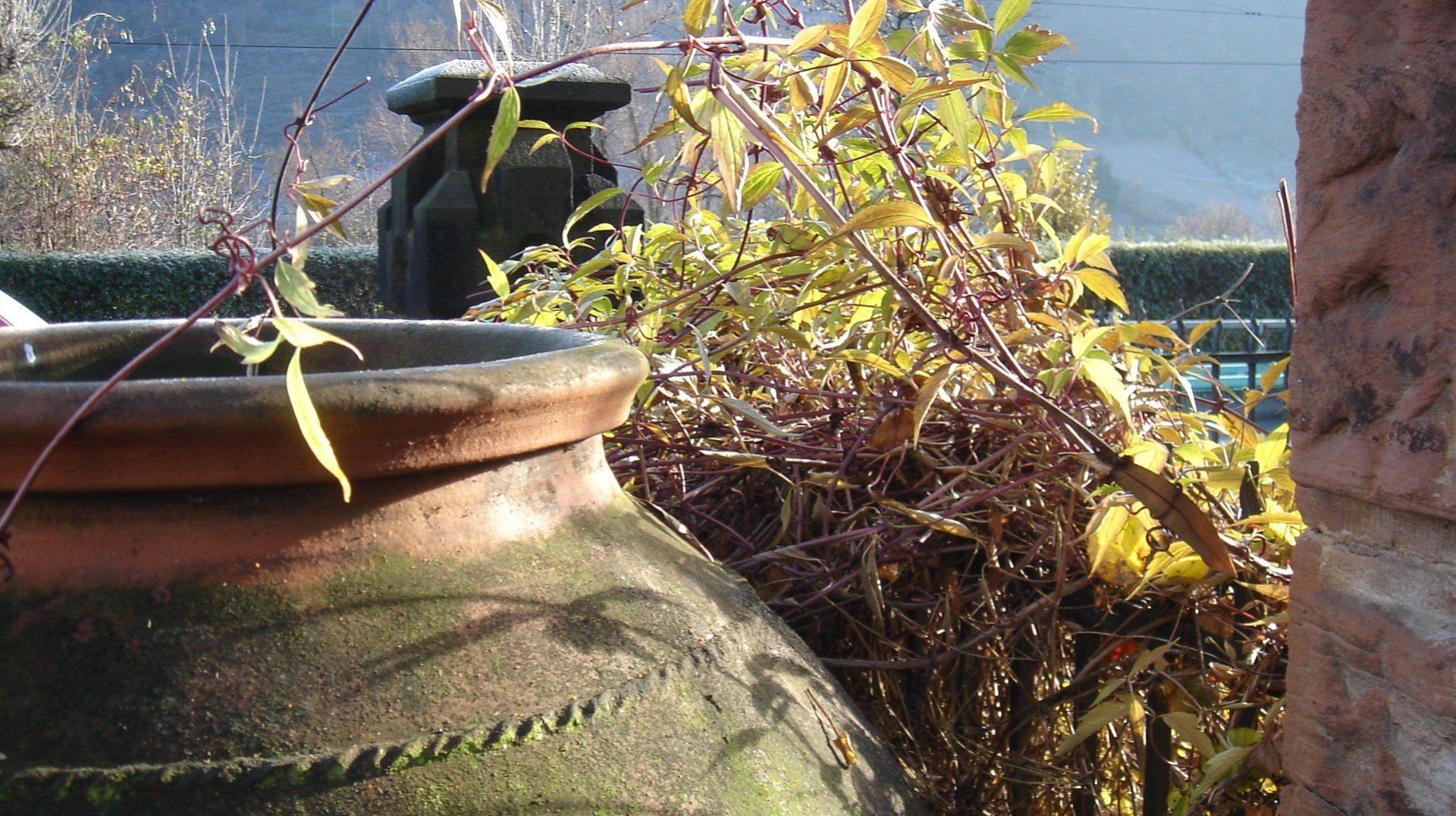Alles hat seine Zeit. Bei der Grundsteinlegung von Kellerei und Wohngebäude des heutigen Weinguts Heymann–Löwenstein im Jahre 1898 wurde, der Begriff „Nachhaltig“ noch im sehr wörtlichen Sinne gebraucht. Wer damals etwas auf sich hielt und über die notwendigen finanziellen Mittel verfügte baute auf Haltbarkeit, baute für die nachfolgenden Generationen. Begriffe wie Eigenkapitalverzinsung und Abschreibungen waren eher untergeordnete Kategorien. Dafür spielten Aspekte der Bausoziologie, wie wir es heute nennen, eine große Rolle. Das Gebäude sollte schön sein, sollte etwas hermachen. Die in unserer Region üblicherweise verbauten Steine aus den umliegenden Schieferbrüchen kamen daher nur in den Tonnengewölben des Fasskellers und in Teilen der Wirtschaftsräume zum Einsatz. Der größte Teil statisch relevanter Mauern wurde mit stabilen Ziegelsteinen hoch gezogen. Und als die Fassade prägende Ecksteine und Gesimse sowie für die schmucken Rundbögen und die mit Kapitellen verzierten Säulen der Loggia wurden Sandsteine aus den unweit an der Lahn gebrochenen Sandstein dekorativ positioniert. Nicht tragende Wände wurden zwischen den Holzbalken mit Bimssteinen ausgemauert. Sie werden heute noch in der Region aus der Vulkanasche des vor 12000 Jahren ausgebrochenen Vulkans „Maria Laach“ hergestellt. Und das Dach wurde selbstverständlich mit den in der Region hergestellten Platten aus Tonschiefer gedeckt.

Image title
Untertitel hier einfügenButton
Image title
Untertitel hier einfügenButton
Image title
Untertitel hier einfügenButton
Image title
Untertitel hier einfügenButton
Image title
Untertitel hier einfügenButton
Image title
Untertitel hier einfügenButton
Image title
Untertitel hier einfügenButton
Image title
Untertitel hier einfügenButton
Image title
Untertitel hier einfügenButton
Image title
Untertitel hier einfügenButton
Image title
Untertitel hier einfügenButton
Image title
Untertitel hier einfügenButtonImage title
Untertitel hier einfügenButton
Image title
Untertitel hier einfügenButton
Image title
Untertitel hier einfügenButton
Image title
Untertitel hier einfügenButton
Image title
Untertitel hier einfügenButton
architecture
Form - function - energy


Built to last. So far - so sustainable. But what about the carbon footprint of the American Pich-Pine floors, the electricity from the dynamo of a coal-fired steam engine, the lighting and the cooking flames made from self-produced, highly explosive carbide gas? The building and management of that time has now given way to a more differentiated approach and approach. After all, not only has knowledge increased. The tools and materials available also allow differentiated discussions about the various aspects of sustainability.

While looking for an architect to implement our ideas, we met Mr. Kappler, a master builder whose family roots lie in the wood industry. He convinced us that grape processing and bottle filling, ie damp rooms, high-pressure cleaners & CO, do not pose any problems for a modern wooden construction and that the durability of wooden houses corresponds to that of "normal" construction. So we went for wood. As a sandwich, the beams are clad on both sides with untreated OFD panels. In between, the newspaper snippets made inert by water glass (hopefully not too much "picture") provide the necessary insulation. In the damp rooms, waterproof panels were installed instead of OFD panels. And outside, a front, well-ventilated facade protects the wood from the weather. The facade itself is protected by plaster colored through with mineral paints. We are happy to know that no preservatives have been used anywhere! The roofs are designed as green flat roofs, a PV system is installed on a partial area.

Form. The space to be built on is framed by a neat chapel built in neo-Gothic style and the fin-siècle winery. The historical optimism of this time came to an abrupt end with the First World War and the subsequent economic crisis. The planned extension of the building could not be realized and a large, windowless gable has been an unflattering sight ever since. Our answer: The extension conceals the gable. The eye is drawn to the new building structure, which creates sufficient contrast to the historical surroundings through a modern design language and at the same time guarantees a harmonious connection through materials and colors.

Obwohl die Fensterflächen aus Energiespargründen klein gehalten sind, werden die Räume als ausreichend Hell empfunden. Fenster und Türen in gleicher Formensprache verbinden Alt- und Neubau und verweisen – auf einer Lichtachse angeordnet – durch unterschiedliche Materialen auf ihre Entstehungszeit.

The architectural influence on people and wine during grape processing is more subtle: in the cube, the focus is on the number nine. The base is 9 by 9 and the height is 8.10 meters. Just as a leading tone in music leads to the next octave, the number 9 evokes the jump to the next higher dimension of our decimal system, to a higher quality. Grapes are sorted in the cube and pressed into grape juice. And after fermentation and maturation in the cellar vaults, they see the light of day again as wine and are drawn into bottles.
From a different perspective:
Fits to:

Image title
Untertitel hier einfügenButton
Image title
Untertitel hier einfügenButton
Image title
Untertitel hier einfügenButton
Image title
Untertitel hier einfügenButton
Image title
Untertitel hier einfügenButton
Image title
Untertitel hier einfügenButton
Image title
Untertitel hier einfügenButton
Image title
Untertitel hier einfügenButton
Image title
Untertitel hier einfügenButton
Image title
Untertitel hier einfügenButton
Image title
Untertitel hier einfügenButton
Image title
Untertitel hier einfügenButtonImage title
Untertitel hier einfügenButton
Image title
Untertitel hier einfügenButton
Image title
Untertitel hier einfügenButton
Image title
Untertitel hier einfügenButton
Image title
Untertitel hier einfügenButton
architecture
Form - function - energy

Alles hat seine Zeit. Bei der Grundsteinlegung von Kellerei und Wohngebäude des heutigen Weinguts Heymann–Löwenstein im Jahre 1898 wurde, der Begriff „Nachhaltig“ noch im sehr wörtlichen Sinne gebraucht. Wer damals etwas auf sich hielt und über die notwendigen finanziellen Mittel verfügte baute auf Haltbarkeit, baute für die nachfolgenden Generationen. Begriffe wie Eigenkapitalverzinsung und Abschreibungen waren eher untergeordnete Kategorien. Dafür spielten Aspekte der Bausoziologie, wie wir es heute nennen, eine große Rolle. Das Gebäude sollte schön sein, sollte etwas hermachen. Die in unserer Region üblicherweise verbauten Steine aus den umliegenden Schieferbrüchen kamen daher nur in den Tonnengewölben des Fasskellers und in Teilen der Wirtschaftsräume zum Einsatz. Der größte Teil statisch relevanter Mauern wurde mit stabilen Ziegelsteinen hoch gezogen. Und als die Fassade prägende Ecksteine und Gesimse sowie für die schmucken Rundbögen und die mit Kapitellen verzierten Säulen der Loggia wurden Sandsteine aus den unweit an der Lahn gebrochenen Sandstein dekorativ positioniert. Nicht tragende Wände wurden zwischen den Holzbalken mit Bimssteinen ausgemauert. Sie werden heute noch in der Region aus der Vulkanasche des vor 12000 Jahren ausgebrochenen Vulkans „Maria Laach“ hergestellt. Und das Dach wurde selbstverständlich mit den in der Region hergestellten Platten aus Tonschiefer gedeckt.

Built to last. So far - so sustainable. But what about the carbon footprint of the American Pich-Pine floors, the electricity from the dynamo of a coal-fired steam engine, the lighting and the cooking flames made from self-produced, highly explosive carbide gas? The building and management of that time has now given way to a more differentiated approach and approach. After all, not only has knowledge increased. The tools and materials available also allow differentiated discussions about the various aspects of sustainability.

While looking for an architect to implement our ideas, we met Mr. Kappler, a master builder whose family roots lie in the wood industry. He convinced us that grape processing and bottle filling, ie damp rooms, high-pressure cleaners & CO, do not pose any problems for a modern wooden construction and that the durability of wooden houses corresponds to that of "normal" construction. So we went for wood. As a sandwich, the beams are clad on both sides with untreated OFD panels. In between, the newspaper snippets made inert by water glass (hopefully not too much "picture") provide the necessary insulation. In the damp rooms, waterproof panels were installed instead of OFD panels. And outside, a front, well-ventilated facade protects the wood from the weather. The facade itself is protected by plaster colored through with mineral paints. We are happy to know that no preservatives have been used anywhere! The roofs are designed as green flat roofs, a PV system is installed on a partial area.

Form. The space to be built on is framed by a neat chapel built in neo-Gothic style and the fin-siècle winery. The historical optimism of this time came to an abrupt end with the First World War and the subsequent economic crisis. The planned extension of the building could not be realized and a large, windowless gable has been an unflattering sight ever since. Our answer: The extension conceals the gable. The eye is drawn to the new building structure, which creates sufficient contrast to the historical surroundings through a modern design language and at the same time guarantees a harmonious connection through materials and colors.

Obwohl die Fensterflächen aus Energiespargründen klein gehalten sind, werden die Räume als ausreichend Hell empfunden. Fenster und Türen in gleicher Formensprache verbinden Alt- und Neubau und verweisen – auf einer Lichtachse angeordnet – durch unterschiedliche Materialen auf ihre Entstehungszeit.

The architectural influence on people and wine during grape processing is more subtle: in the cube, the focus is on the number nine. The base is 9 by 9 and the height is 8.10 meters. Just as a leading tone in music leads to the next octave, the number 9 evokes the jump to the next higher dimension of our decimal system, to a higher quality. Grapes are sorted in the cube and pressed into grape juice. And after fermentation and maturation in the cellar vaults, they see the light of day again as wine and are drawn into bottles.
Viewed through terroir glasses:
For further reading:
Winery> Architecture
architecture
Form - function - energy

Alles hat seine Zeit. Bei der Grundsteinlegung von Kellerei und Wohngebäude des heutigen Weinguts Heymann–Löwenstein im Jahre 1898 wurde, der Begriff „Nachhaltig“ noch im sehr wörtlichen Sinne gebraucht. Wer damals etwas auf sich hielt und über die notwendigen finanziellen Mittel verfügte baute auf Haltbarkeit, baute für die nachfolgenden Generationen. Begriffe wie Eigenkapitalverzinsung und Abschreibungen waren eher untergeordnete Kategorien. Dafür spielten Aspekte der Bausoziologie, wie wir es heute nennen, eine große Rolle. Das Gebäude sollte schön sein, sollte etwas hermachen. Die in unserer Region üblicherweise verbauten Steine aus den umliegenden Schieferbrüchen kamen daher nur in den Tonnengewölben des Fasskellers und in Teilen der Wirtschaftsräume zum Einsatz. Der größte Teil statisch relevanter Mauern wurde mit stabilen Ziegelsteinen hoch gezogen. Und als die Fassade prägende Ecksteine und Gesimse sowie für die schmucken Rundbögen und die mit Kapitellen verzierten Säulen der Loggia wurden Sandsteine aus den unweit an der Lahn gebrochenen Sandstein dekorativ positioniert. Nicht tragende Wände wurden zwischen den Holzbalken mit Bimssteinen ausgemauert. Sie werden heute noch in der Region aus der Vulkanasche des vor 12000 Jahren ausgebrochenen Vulkans „Maria Laach“ hergestellt. Und das Dach wurde selbstverständlich mit den in der Region hergestellten Platten aus Tonschiefer gedeckt.

Built to last. So far - so sustainable. But what about the carbon footprint of the American Pich-Pine floors, the electricity from the dynamo of a coal-fired steam engine, the lighting and the cooking flames made from self-produced, highly explosive carbide gas? The building and management of that time has now given way to a more differentiated approach and approach. After all, not only has knowledge increased. The tools and materials available also allow differentiated discussions about the various aspects of sustainability.

While looking for an architect to implement our ideas, we met Mr. Kappler, a master builder whose family roots lie in the wood industry. He convinced us that grape processing and bottle filling, ie damp rooms, high-pressure cleaners & CO, do not pose any problems for a modern wooden construction and that the durability of wooden houses corresponds to that of "normal" construction. So we went for wood. As a sandwich, the beams are clad on both sides with untreated OFD panels. In between, the newspaper snippets made inert by water glass (hopefully not too much "picture") provide the necessary insulation. In the damp rooms, waterproof panels were installed instead of OFD panels. And outside, a front, well-ventilated facade protects the wood from the weather. The facade itself is protected by plaster colored through with mineral paints. We are happy to know that no preservatives have been used anywhere! The roofs are designed as green flat roofs, a PV system is installed on a partial area.

Form. The space to be built on is framed by a neat chapel built in neo-Gothic style and the fin-siècle winery. The historical optimism of this time came to an abrupt end with the First World War and the subsequent economic crisis. The planned extension of the building could not be realized and a large, windowless gable has been an unflattering sight ever since. Our answer: The extension conceals the gable. The eye is drawn to the new building structure, which creates sufficient contrast to the historical surroundings through a modern design language and at the same time guarantees a harmonious connection through materials and colors.

Obwohl die Fensterflächen aus Energiespargründen klein gehalten sind, werden die Räume als ausreichend Hell empfunden. Fenster und Türen in gleicher Formensprache verbinden Alt- und Neubau und verweisen – auf einer Lichtachse angeordnet – durch unterschiedliche Materialen auf ihre Entstehungszeit.

The architectural influence on people and wine during grape processing is more subtle: in the cube, the focus is on the number nine. The base is 9 by 9 and the height is 8.10 meters. Just as a leading tone in music leads to the next octave, the number 9 evokes the jump to the next higher dimension of our decimal system, to a higher quality. Grapes are sorted in the cube and pressed into grape juice. And after fermentation and maturation in the cellar vaults, they see the light of day again as wine and are drawn into bottles.
From a different perspective:
Fits to:



